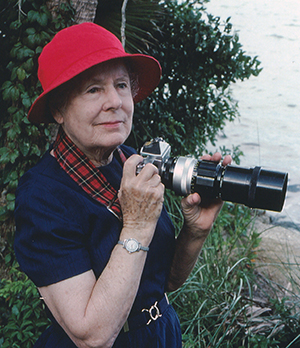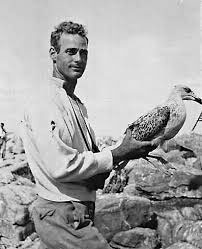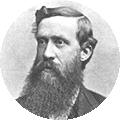Grants & Awards
You are here : Home / Grants & Awards / Cruickshank Research Award
Helen G. and Allan D. Cruickshank Research Award
The Helen G. and Allan D. Cruickshank Research Awards are given to support projects dealing with wild birds in Florida. Proposals submitted for research awards should be directed at improving knowledge of Florida birds and should propose work to be done in Florida. Students (undergraduate to PhD) are especially encouraged to apply; post-doctoral level scientists and non-profit organizations or their representatives may also be considered for funding. The maximum amount awarded each year typically falls in the range of $2000-2500; multiple awards for smaller grants are occasionally provided.
Proposal Due Date: February 15 of each year.
Proposal Preparation and Evaluation
Applications must contain 4 distinct parts:
(1) an updated CV of the applicant with current contact information;
(2) a research proposal of up to 8 double-spaced pages (4 single-spaced; excluding references, figures, and tables);
(3) a 1-page research budget showing total project costs, and what portion of the total this award will cover; and
(4) a timeline indicating when work will be completed.
Research proposals must be well-written and contain an Introduction/Background section with Literature Review; a clear statement of Research Objectives, Study Design, proposed Methods and Materials that include information on the study area/species, and a short Synthesis and Significance section at the end emphasizing why funding this project will enhance knowledge or conservation of Florida birds.
All application materials should be put into a single PDF file, in order, and emailed to the Committee Chair with CRUICKSHANK PROPOSAL in the title line.
Applications should be strong in one or more of these focal areas:
(1) basic biology (new understanding of bird biology in area(s) of specialization)
(2) conservation biology (new understanding of how populations, species, or communities (patterns, processes) are affected by humans such that this understanding could lead to designing better protection of avian biodiversity)
(3) management application (testing of management techniques that foster native birds: species, populations, communities)
If you are interested in participating in this program, please email: Beth Forys notifying your intent to start the process.
| Year | Recipient | Institution | Status | Project Title |
|---|---|---|---|---|
| 2023 | Zachery Holmes | University of Florida | MS student | Avian Biodiversity in Florida Rangelands: The Role of Pasture Type and Management Strategies |
| 2023 | Connor O'Brien | Eckerd College | Undergraduate | Influence of temperature on Least Tern egg and chick survival |
| 2022 | Morgan Slevin | Florida Atlantic University | PhD candidate | "Take it easy! Testing stress' effect on the microbiome, health, and ornamentation of a wild songbird" |
| 2021 | Eliza Stein | Lousiana State University | MS student | Does habitat management influence prey selection by a declining aerial insectivore? |
| 2021 | Odile Maurelli | University of Florida | MS student | Noise pollution impacts on nocturnal incubation behavior and nestling stress in Eastern bluebirds (Sialia sialis) |
| 2020 | Mitch Walters | University of Florida | PhD candidate | Singing in the city: determining the drivers and consequences of avian acoustic richness patterns across urbanization gradients in Florida |
| Young Ha Suh | Cornell University | PhD candidate | Tracking movement to understand dispersal and habitat selection | |
| 2019 | Donna Molfetto | Florida International University | PhD candidate | Investigating the population dynamics of an avian apex predator across an urban gradient |
| 2018 | Mary Mack Gray | Florida State University | MS candidate | Considering the role of personality and genetics in translocating Brown-headed Nuthatches (Sitta pusilla) |
| 2018 | Tram Ngyen | Cornell University | PhD candidate | Understanding the genomic consequences of habitat loss and fragmentation on populations of threatened Florida scrub-jays (Aphelocoma coerulescens) |
| 2017 | Kristen Malone | University of Florida | PhD candidate | |
| 2016 | Jessica Cusick | Florida State University | PhD candidate | Investigating Proximate Causes of Individual Variation in Cooperative Behavior (Brown-headed Nuthatches,Sitta pusilla) |
| 2015 | Rebecca Windsor | University of South Florida | PhD candidate | Structural color variation in the Florida Scrub-Jay (Aphelocoma coerulescens): the effects of environmental conditions on feather ultraviolet reflectance |
| 2014 | Emily Elderbrock | University of Memphis | PhD candidate | Development of the adult phenotype in Florida Scrub-Jays |
| 2013 | Blake Jones | University of Memphis | PhD candidate |
Learned antipredator behavior: a hormonal mechanism?
|
| 2012 | Sara Bebus | University of Memphis | PhD candidate | Long-Term Effects of Nestling Condition on Personality and Cognition in Florida Scrub-Jays (Aphelocoma coerulescens) |
| 2011 | Rafael A. Gálvez and Ernesto Ruelas Inzunza | Florida Keys Hawkwatch | Biologists | Raptor Population Monitoring at the Florida Keys |
| 2010 | Dereck Thrasher | University of Florida | Undergraduate | Assessment of Critical Habitat for Eastern Painted Buntings (Passerina ciris ciris) in NE Florida |
| 2010 | Evan Adams | Biodiversity Research Institute | Biologist | Impacts of Non-breeding Mercury Exposure on Migration Physiology and Breeding Ground Preparation |
| 2009 | Travis Wilcoxen | University of Memphis | PhD candidate | Influence of Heredity and Food Abundance on Parental Effort in the Florida Scrub-Jay (Aphelocoma coerulescens) |
| 2008 | Mariane Korosy | University of Central Florida | PhD candidate | Non-breeding Season Diet Reconstruction and Habitat Partitioning Among Florida Grasshopper (Ammodramus savannarum floridanus), Bachman's (Peucaea aestivalis), and Henslow's (Ammodramus henslowii) Sparrows in Florida Dry Prairie |
| 2007 | Garth Herring | Florida Atlantic University | PhD candidate | Validating the Use of Stress Proteins as a Metric of Physiological Condition of Everglades Wading Birds |
| 2006 | ||||
| 2005 | ||||
| 2004 | Matthew Reetz | University of Florida | PhD candidate | Brown-headed Cowbird (Molothrus ater) Expansion into Florida and Interactions with Native Songbird Hosts |
| 2004 | Lori Blanc | Virginia Tech | Assistant Professor | Experimental Study of the :ongleaf Pine Cavity-nesting Bird Community: the Role of the Red-cockaded Woodpecker (Picoides borealis) |
| 2003 | ||||
| 2002 | ||||
| 2001 | Matthew S. Schrader | Is There a Parasite Mediated Cost of Reproduction in the Red-bellied Woodpecker (Melanerpes carolinus)? | ||
| 2000 | Kimberly Boots Brand | Body Mass Variation in Breeding Florida Scrub-Jays (Aphelocoma coerulescens) | ||
| 2000 | David L. Leonard | University of Florida | PhD candidate | A Habitat, Re-introduction, and Genetic Study of the White-breasted Nuthatch (Sitta carolinensis) |
| 2000 | Audrey Washburn | ARCI | Biology | Phylogeography of a Trans-equatorial Migrant: the Swallow-tailed Kite (Elanoides forficatus) |
| 1999 | Pamela Bowen | A Statewide Population Survey of the Burrowing Owl (Athene cunicularia) in Florida | ||
| 1998 | Margaret Cole | Effects of Erosion and Vehicular Traffic on Shorebird Distribution and Prey Availability Along Cape San Blas, Florida |
Allan Dudley Cruickshank was a nationally known ornithologist who has been described as “a modern Audubon with a camera.” Cruickshank, a lecturer and teacher, was on the staff of the National Audubon Society for 37 years. He wrote and illustrated many magazine articles and a number of books on ornithology, some with the aid of his wife, Helen.
Pocket Guides included “Birds Around New York City,” “Wings in the Wilderness,” “Hunting With the Camera,” “Cruickshank's Pocket Guide to Birds,” “1,001 Questions About Birds” and “Summer Birds of Lincoln County, Maine.”
He was for many years the official photographer of the National Audubon Society, and his pictures appeared in more than 175 books and won awards in numerous exhibitions.
His interest began at the age of 10. He was on his way to West 23rd Street in New York City to get a newspaper for his mother when he spotted a strange bird—clearly not a pigeon, English sparrow or starling—perched low on a willow tree near Eighth Avenue.
As the boy inched closer, the bird remained calmly on its perch and studied him. The bird, the boy was to learn, was a screech owl, as uncommon in the area as willow trees now are.
Excited by the experience, the boy started going uptown to look for birds in Central Park. And when his family moved to the Bronx, then largely rural, he was ecstatic over the specimens he found in woodlands, gardens, and orchards.

It has been said of Mr. Cruickshank that he had “flown, climbed (and fallen), crawled and ridden into almost every corner of North America to study wildlife in its native habitat.
He was born in St. Thomas, the Virgin Islands, on Aug. 29, 1907, to a Scottish father and a French mother. He came to this country at the age of two and lived mostly in and around New York City.
Mr. Cruickshank, who attended New York University, was former president of the Linnaean Society of New York, and a member of the Wilson Ornithological Club, the Nature Conservancy, the Wilderness Society and the Izaak Walton League, among others.
With his wife Helen he received the John Burroughs Medal for 1949 for “Flight Into Sunshine.” He also received several other awards.

Allan D. Cruickshank

“ Birds may be sought anywhere, at any time; they should be sought everywhere, at all times. ”

